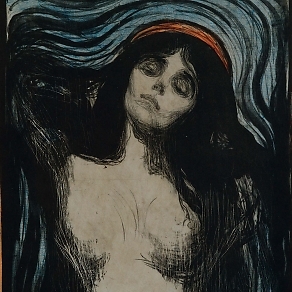The first comprehensive overview of Edvard Munch's oeuvre in the Netherlands brings together more than 150 paintings and works on paper. The Norwegian painter, one of the most fascinating artists of the late nineteenth and early twentieth century, is primarily known to the public through his painting ‘The Scream' (1893). The works on exhibition at the Kunsthal Rotterdam - all from private collections - will be shown together only once, a chance in a lifetime for anyone wanting to learn more about the oeuvre of Edvard Munch. Munch paints about life, love and death. Complex emotions like loneliness, dread and anxiety are the main themes of his work. The subject matter, the powerful compositions, the fluid lines and the clever use of colour and materials make his paintings reach out to us to this day.
Experiment and Expression
Edvard Munch had a major influence on the development of expressionism in the late nineteenth and early twentieth century. From the start of his artistic career in 1880 he radically broke with all prevailing artistic conventions. In reaction to the rigid bourgeois morality of his time, he joined progressive artists' groups in Kristiania (now Oslo). In search of his own artistic expression he experimented with different materials and techniques. He was influenced by contemporary artistic styles, like naturalism, impressionism and symbolism, and absorbed them into his own unique visual language. Munch's inspiration for the themes of his paintings came from literature, from writers like August Strindberg and Henrik Ibsen. The setbacks in his life - the death of his mother and young sister - left deep scars. With exceptional sensitivity he depicts in his paintings, lithographs, drawings and engravings the helplessness and fear that death, illness and degeneration bring.
Overwhelming Oeuvre
The exhibition shows the development and formation of Munch's impressive oeuvre. The opening of his first big exhibition at the Verein Berliner Künstler (Association of Berlin Artists) in Berlin in 1892 lead to a public outcry. The fleeting and fragmented style of his work, which would typify modern art at the beginning of the twentieth century, was mercilessly criticised by the press. The exhibition closed prematurely and Munch became famous overnight in Germany. During his stay in Paris, Munch created a lot of graphic art, including his well-known lithograph series of the Madonna, a mesmerising portrait of a female framed by spermatozoa and accompanied by a foetus with a skull-like face. From a compositional point of view, life and death, the two main themes in Munch's work, work surprisingly well together.
The exhibition is produced by the Pinacotheque in Paris.
